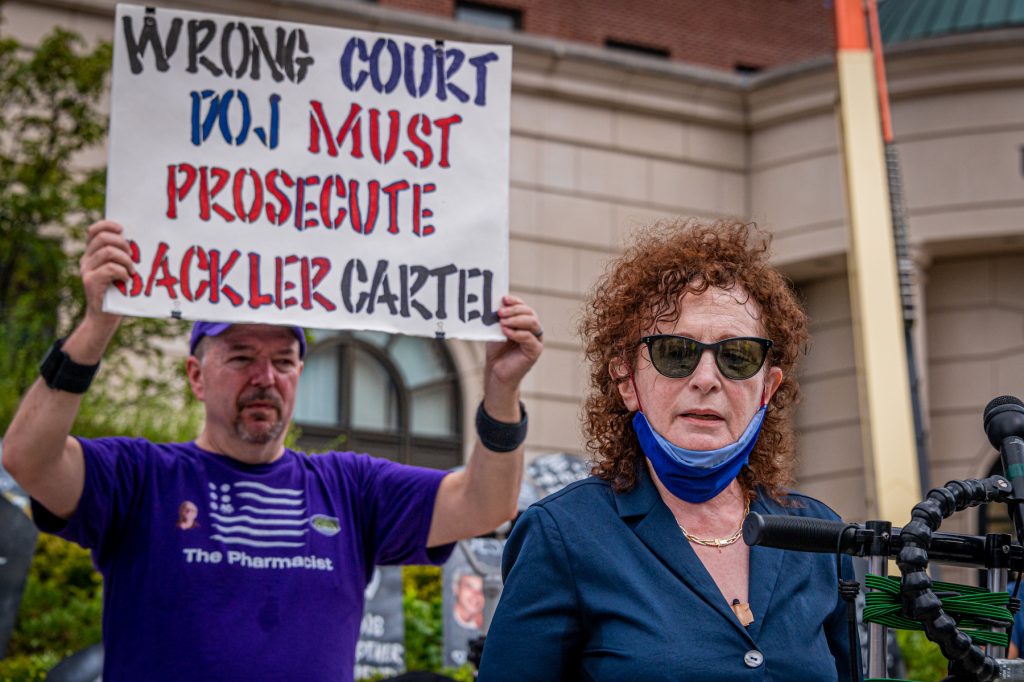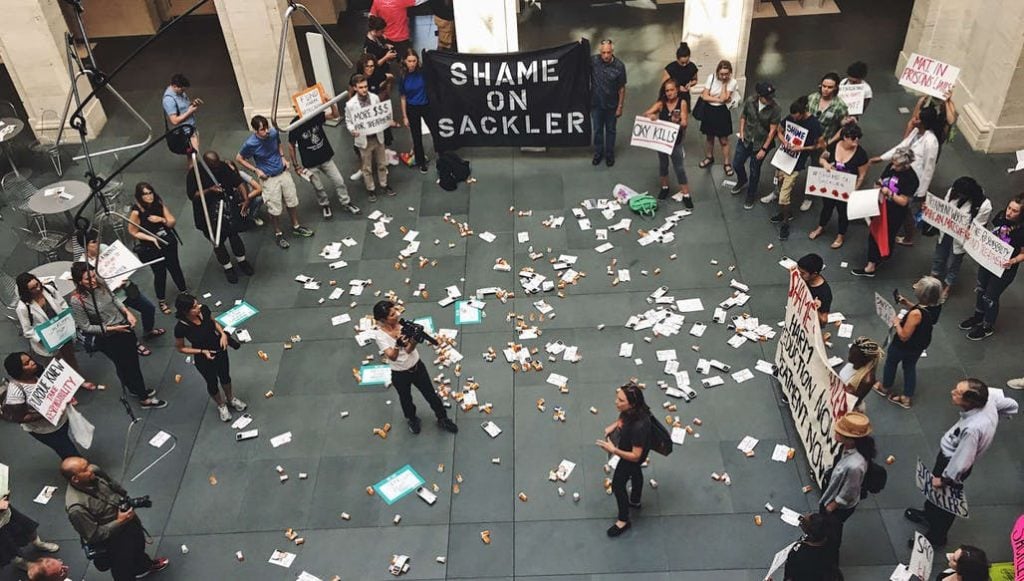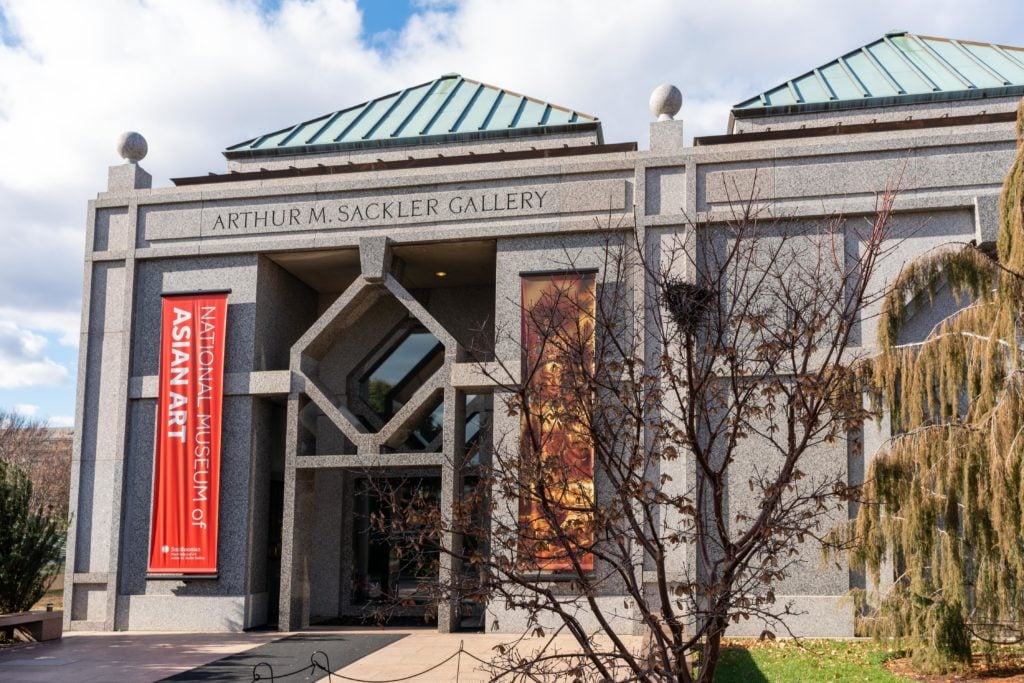Museums & Institutions
Harvard Rejects Calls to Rename Arthur M. Sackler Museum
The museum is named for Arthur M. Sackler, who died before his brothers introduced Oxycontin to market.

The museum is named for Arthur M. Sackler, who died before his brothers introduced Oxycontin to market.

Sarah Cascone

Harvard University in Cambridge, Massachusetts, has decided to keep the Sackler name in place at its Arthur M. Sackler Museum (one of the three Harvard Art Museums) and the Arthur M. Sackler Building.
In October 2022, a group of students submitted a 23-page proposal demanding that both sites be rechristened. The committee tasked with reviewing their request issued a report on Wednesday announcing their decision, as reported by the Harvard Crimson.
Institutions around the world have stripped the Sackler name from their doors since 2018, when artist Nan Goldin launched an advocacy organization called Sackler P.A.I.N. in an effort to hold the Sackler family accountable for their role in the deadly opioid crisis. The group staged protests at Harvard in 2018 and again in 2023, the latter in support of students’ renaming efforts.
The Sackler’s company, Purdue Pharma, began selling the prescription painkiller OxyContin in 1995. Though it was highly addictive, Purdue Pharma marketed the drug as safe for longterm use. The effects were catastrophic: Opioid use caused 564,000 deaths in the U.S. between 1999 and 2020, according to the Centers for Disease Control and Prevention.

Nan Goldin protests outside the United States Bankruptcy Court in White Plains to call out the United States justice system for allowing the billionaire Sackler Family to walk away unscathed after igniting one of the worst public health care scandals in the history of the nation. Photo by Erik McGregor/LightRocket via Getty Images.
Amid a sea of lawsuits, the company filed for bankruptcy in 2019. The most recent settlement was overturned in June by the U.S. Supreme Court. It would have seen the Sacklers pay $6 billion to victims and their families, as well as to state efforts to combat the abuse of opioids, in exchange for civil immunity.
But not all members of the Sackler family are involved in the case. Arthur Sackler started Purdue Pharma with his two brothers, Mortimer and Raymond, who inherited his third of the company upon his death in 1987. That was before the development of OxyContin, and Arthur’s descendants did not profit from its sale.
The Harvard students who called for the buildings’ renaming were well aware of the distinction. They believed that Arthur is still partly culpable for the family’s misdeeds, as he was the one who developed the marketing techniques that were so instrumental in Oxycontin’s success.

Sackler PAIN protesting the Arthur M. Sackler Museum at Harvard in 2020. (The museum is named after a Sackler family member who did not benefit from the sale of oxycontin. Photo courtesy of Sackler PAIN.
Arthur’s widow, Jillian Sackler, has been outspoken in her defense of her branch of the family.
“I am very pleased to learn that Harvard University will leave my husband’s name intact,” she told Artnet News in an email. “My husband was strictly ethical and had nothing to do with opioids or deceptive and/or aggressive medical advertising. He was a pioneer of accurate medical advertising and a force for good in pharmaceuticals and world culture.”
“The committee was not persuaded by the proposal’s arguments that denaming is appropriate because Arthur Sackler’s name is tainted by association with other members of the Sackler family or because Arthur Sackler shares responsibility for the opioid crisis due to his having developed aggressive pharmaceutical marketing techniques that others misused after his death,” the report read.
The committee concluded that it was impossible to know how Arthur Sackler would have approached sales of the addictive, potentially fatal drug, and unfair to judge him for how his marketing innovations were put to use after his death.
The report acknowledged that “Arthur Sackler’s legacy is complex, ambiguous, and debatable,” and recommended creating additional signage at both buildings that would help tell that story. “Through such contextualization, people will be allowed to form their own judgments about Arthur Sackler and the naming.”
That differs from how the issue was handled by neighboring Tufts University, which in 2019 became one of the first institutions to cut ties with the Sacklers. It removed all trace of the family’s name, including the Arthur M. Sackler Center for Medical Education.

The Arthur M. Sackler Gallery of Art. Photo courtesy of the Smithsonian Institution.
But Harvard isn’t the first institution to make a distinction between the Sackler brothers. It was a major blow to the Sackler family when New York’s Metropolitan Museum of Art stripped their name from the Sackler Wing and several other spaces in 2021. But the Arthur M. Sackler Gallery escaped unscathed.
Similarly, the Smithsonian has made it clear that it will not rename the Arthur M. Sackler Gallery in Washington, D.C. But the museum and the Smithsonian’s other Asian art museum, the Freer Gallery of Art, were collectively rebranded as the National Museum of Asian Art in 2019. The Elizabeth A. Sackler Center for Feminist Art at the Brooklyn Museum is named for Arthur’s daughter.
Otherwise, you’d be hard-pressed to find an institution anywhere in the world still named in honor of the Sacklers. It disappeared at the Louvre in Paris in 2019, New York’s Dia Art Foundation in 2020, and London’s Serpentine Galleries and the Jewish Museum Berlin in 2021. Outside the art world, New York University’s Langone Medical Center removed the Sackler name in 2020, and Edinburgh University and the University of Glasgow in 2021.
In 2022, a string of London institutions followed suit, with the Tate, the National Gallery, the British Museum, and the Victoria & Albert Museum finally dropping the Sackler name. So did the Guggenheim Museum in New York, and, in 2023, the Ashmolean Museum in Oxford.
Perhaps the last known hold out was the American Museum of Natural History in New York. But the websites for the Sackler Institute for Comparative Genomics and Sackler Educational Laboratory now redirect to pages for the Institute for Comparative Genomics and Virtual Human Origins Educational Lab, suggesting a quiet renaming that went unreported in early 2023.